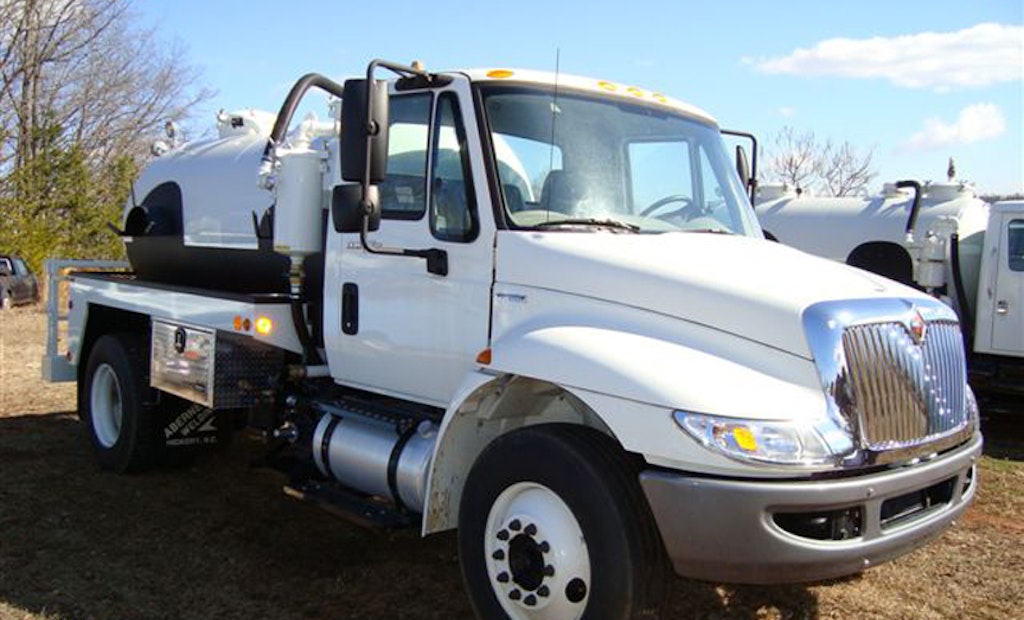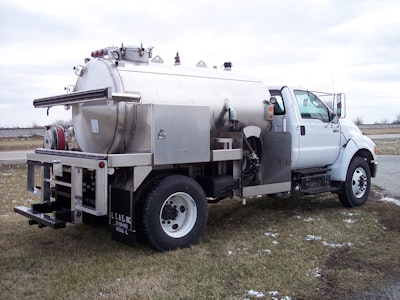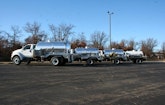
Interested in Portable Sanitation?
Get Portable Sanitation articles, news and videos right in your inbox! Sign up now.
Portable Sanitation + Get AlertsChoose wisely. That mantra holds true for just about anything you purchase for your business. But for septic service and portable restroom contractors, it holds especially true when choosing a tank for your service trucks.
Options are vast — ranging from material and size to capacity and durability. And, of course, there is always price.
Here one expert in the field discusses his tips for selecting a tank. Josh and Shannon Reading own portable restroom company JR’s Johns in Monee, Ill., and they also have sister businesses in septic service and sewer and utility construction.
JR’s Johns operates two vacuum trucks: a 2005 Ford F-650 with 1,000-gallon waste, 500-gallon freshwater stainless steel tank, and a 2012 Fuso FE-160 with 16-foot flatbed and lift gate and 300-gallon waste/150-gallon freshwater steel slide-in unit.
1. Price
“Price is always on all contractors’ minds,” admits Josh Reading, noting that cost should not be the only consideration. He recommends getting a few price quotes for tanks, but not too many to be confusing. Maybe select two or three manufacturers and price them out. Keep in mind, prices also will vary depending on the material of the tank.
2. Manufacturer
Both of JR’s Johns’ tanks are made by Imperial Industries, located in the neighboring state of Wisconsin. “We also consider which companies are local. That’s important for us,” says Reading, especially for readily getting service and parts.
Reading says he does remain loyal to Imperial. He bought his first two tanks from them and will consider them for a third tank he hopes to add soon.
Check out these tank and tank/truck package solutions:
- The International 4300 series truck with 1,100-gallon waste/400-gallon freshwater steel tank from Abernethy Welding & Repair Inc. has a gearbox-driven, Masport HXL75V 230 cfm vacuum pump. Features include dual pumping and water service on both sides of the tank, air-charged 40 psi freshwater system with garden hose connections and hose hooks on both sides of the tank. Other features include 2-inch suction hoses (33 feet long) and hooks on both sides of the tank, Rhino-lined catwalks and tank sides, two aluminum toolboxes (18 by 18 by 36 inches), restroom carrier (holds two regular or one ADA unit), and heavy-duty receiver hitch with 7-wire RV trailer plug.
- Portable sanitation vacuum tanks from Mid-State Tank include a 1,500-gallon, two-compartment stainless steel tank with 1,100-gallon waste/400-gallon freshwater compartments installed on a Ford F-750 chassis. The unit has a 20-inch top manway with primary, hose supports, storage cabinets, a work station on both sides, restroom carrier, work lights, sight glasses for the waste compartment, and a sight gauge for the water compartment. Aluminum tanks are available.
- The PTM portable restroom service truck from Imperial Industries Inc. can be built with steel tank capacities of 980 to 2,150 gallons mounted on a choice of a Ford F550 or a Dodge 5500 Series chassis. Imperial can customize the truck with a variety of features. Aluminum units are also available.
- Available on Peterbilt, Ford, Hino or Freightliner chassis, the MD1600 service vehicle from Satellite Industries has a 1,100-gallon waste/500-gallon freshwater tank. Features include reinforced stainless steel skirting, two powder-coated storage cabinets with shelves and keyed locks. The tank has a coated freshwater compartment with manway, sight glasses and internal safety baffle. The DOT safety equipment package includes flag and reflector, first-aid kit and fire extinguisher.
- The 2012 International 58,000-pound GVW portable restroom vacuum truck from Best Enterprises features a 3,600-gallon stainless steel tank, overflow sensor control, spring-mounted rear legs to relieve stress, a backup camera with LCD display, a Masport 400 WV pump, three stainless steel toolboxes, a remote-controlled 3,000 psi jetter, an electric hose reel with 275-foot hose, and a nozzle kit. The truck has an angle drive system with dual PTO and warning light in-cab for PTO, and a backup switch on the dash for the jetter. The water compartment features a heater coil and jetter for easy clean out.
- The portable restroom service vehicle from Ledwell features a PTO-driven remote four-way valve, carbon steel or stainless body, and a large water-resistant storage capacity. The truck’s convenience features include rear work lights, a dual toilet carrier with self supporting bed, LED side and rear marker lights, variable freshwater systems, a trailer hitch receiver, high-performance vacuum pump capability, a 2-inch suction hose with ball valve, spring-loaded hose reel with auto rewind, and variable compartment sizes.
3. Material
Manufacturing material is important, especially based on your purpose for the tank. If you’re getting a bigger tank, advises Reading, consider aluminum, which will be lighter. Steel will be heavier, adding to gross vehicle weight. Remember, when the truck is loaded and fully equipped, it cannot exceed the GVW rating so the tank material should be considered.
Portable restroom operators might choose aluminum because they weigh less and can carry a heavier load, but septic contractors will likely opt for steel since they’ll be sucking up rocks and other debris that might damage aluminum.
“Steel’s going to last longer. It’s more durable,” Reading says. But steel is susceptible to rust, so it will require more maintenance. A coating inside the tank will remedy rust to lengthen tank life.
JR’s Johns’ has a stainless steel and a steel tank. Stainless steel will not rust and they last for a very long time. “That was the truck that was available when we needed it. It fit what we needed,” Reading says.
4. Capacity
When choosing the tank capacity, consider the size of your business, and in particular, the length of your routes. JR’s Johns’ sister company, Jean’s Septic, has a 3,600-gallon (all waste) baffled aluminum tank.
“We forgo the longevity with the aluminum tank, but the capacity of the tank was the most important,” Reading notes.
A larger tank capacity allows for emptying more septic tanks per route and it means eliminating trips to the municipal disposal plant to empty the holding tanks. This also reduces drive time for disposal, ultimately saving fuel costs.
5. Truck
While you can buy a service truck separately or both tank and truck together, Reading says, “I would rather have someone build the whole thing — a one-stop shop. I think you can get a better product.”
Reading considers, “What type of truck you need is very important; is it going to be a route truck or a delivery truck?” If your routes aren’t huge, he says you can get away with a flatbed with a tank on it. You can then use the truck for delivering your restrooms as well.
To that end, he has been considering purchasing a square tank truck by Crescent Tank Mfg. of Bloomfield, N.Y. “They put the square tank on the chassis of the truck and it acts as the deck of the truck as well. It saves on the truck size by utilizing the tank as the bed of the truck,” Reading says.
6. Productivity
Before selecting any tank, do some research into their accessibility and ease of use. Are they easy to clean and maintain? Can you get all the sediment out? Does the tank have to be on an incline?
One especially important consideration is whether you’re buying for a service truck or a delivery truck. Some manufacturers might install hoses that can be serviced off either the driver’s or passenger’s side; does your maker/tank offer that flexibility?
Other additional features might be important to your business as well. Consider safety options such as rear work lights, manways, sight glasses and extra storage availability.
7. Reputation
Reading has remained loyal to Imperial Industries based on the reputation he has found with the company. He says contractors should absolutely poll other contractors to see what has worked for them. Get some testimonials. “That’s one thing that’s on my radar,” he says, as he considers purchasing his third tank truck. “The Pumper & Cleaner Environmental Expo is a great opportunity to accomplish this.”
Check out a full-length story on JR's Johns in the November print issue of Pumper.
(All equipment listings from PRO Product Focus, March 2012 and March 2013)










